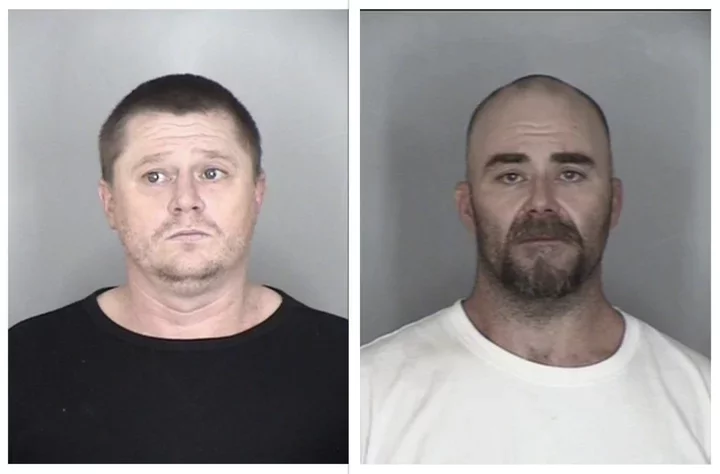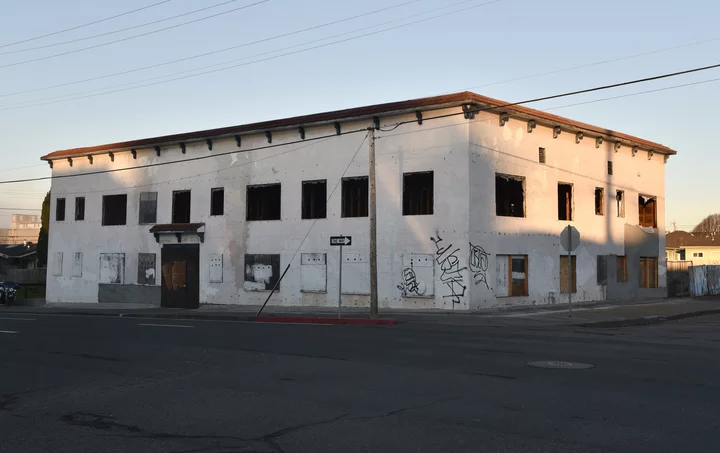Six Rivers Forest Service has Sold a Lot of Tree Cutting Permits this Season
Dezmond Remington / Thursday, Dec. 11 @ 3:30 p.m. / Nature
My own rinkydink Douglas Fir I reaped from Horse Mountain last weekend. Photo by Shea Daly.
Lotta trees in them there hills. They’re blanketed in the things, and this time of year, when every good girl and boy get a yen to put some of the outside inside, people flock to them like ants to a picnic to carry off some prime specimens.
In fact, if you bought a permit and went out there sometime in the last couple weeks and harvested yourself a tree, you bought one out of 2,649 Six Rivers National Forest Christmas tree-cutting permits the Forest Service has sold since they went on sale in November, according to a Forest Service spokesperson who talked to the Outpost today. (If you haven’t bought a permit but want to, get one here.)
To cut a tree down, it must have a diameter smaller than six inches and be farther than 100 feet away from a paved road or 50 feet from a dirt road. Just cutting the top off of a tree isn’t allowed. There are also some areas you’re not allowed to take from, so make sure to consult the maps on the webpage linked above before you go.
BOOKED
Today: 8 felonies, 17 misdemeanors, 0 infractions
JUDGED
Humboldt County Superior Court Calendar: Today
CHP REPORTS
1656 Union St (HM office): Closure of a Road
ELSEWHERE
Governor’s Office: Governor Newsom deploys dedicated teams to fight crime in Stockton, building on existing successful partnerships
Governor’s Office: Governor and LA Rises announce new online resource to further help LA fire survivors navigate rebuilding
KINS’s Talk Shop: Talkshop December 23rd, 2025 – John Ford
Governor’s Office: Governor Newsom’s SAFE Task Force partners with Sacramento to clear encampment
Jury Convicts Two Humboldt County Men of ‘Gruesome’ Double Murder in Butte County
LoCO Staff / Thursday, Dec. 11 @ 1:06 p.m. / Courts
Samuel Ashley (left) and Wesley Evans. | Booking photos via Butte County Sheriff’s Office.
###
PREVIOUSLY
###
Press release from the Butte County District Attorney’s Office:
Two Humboldt County men were each convicted today after a jury trial in Butte County Superior Court for a gruesome double murder in the rural Cherokee area of Butte County.
Butte County District Attorney Mike Ramsey said Samuel Ashley, 43, and Wesley Evans, 45, were each found guilty of two counts of first-degree murder. Additionally, the jury found a special allegation of multiple murder to be true for each defendant.
A homicide investigation was initiated on January 30, 2025, after the badly burned remains of two men were discovered in a vehicle on Condor Road in Cherokee. The investigation found that Ashley and Evans had traveled with the victims from Humboldt County to Butte County.
The victims, Juan Daniel Arreola Solano, 26, and Esequiel Velle Arellano Jr., 22, were identified through DNA samples obtained from family members.
One of the victims repeatedly stated he had a deal for firearms with Ashley and Evans. The five-week jury trial began November 3rd, and the jury deliberated for about 5 hours before reaching their verdict late today.
Ashley and Evans remain in custody without bail and are scheduled to appear in court on January 9, 2026, for sentencing. Ashley and Evans each face a life sentence without the possibility of parole.
Ramsey said, “The nature of the case presented significant investigative challenges, but the Butte County Sheriff’s detective unit did outstanding work.”
Ramsey also noted that the complex prosecution of the case was ably handled by the trial prosecutors, Chief Deputy District Attorney Mark Murphy and Deputy District Attorney Megan Grow, during which 23 witnesses and over 200 exhibits were presented to the jury.
SMOKE over KORBEL? That is a Green Diamond Prescribed Burn
LoCO Staff / Thursday, Dec. 11 @ 11:53 a.m. / Non-Emergencies
Smoke. File photo.
You seeing smoke in Blue Lake or Arcata? That’s probably this, which Green Diamond just told us about:
Green Diamond has initiated a controlled burn near Korbel. Smoke will be visible from Blue Lake, Arcata, and McKinleyville. Burning operations are implemented in coordination with CAL FIRE and North Coast Unified Air Quality Management District.
‘Sunset Heights,’ the City of Eureka’s Housing Project Near Winco, Has Nabbed a $21.7 Million Grant From a State Climate Fund
Hank Sims / Thursday, Dec. 11 @ 10:59 a.m. / Infrastructure
Future location of “Sunset Heights.”
Eureka city government got some good news yesterday, when it found out that a state agency had awarded its “Sunset Heights” development near the Eureka Mall a $21.7 million grant from the California Strategic Growth Council.
The grant, which comes from the council’s “Affordable Housing and Sustainable Communities” fund, will help finance the building of 43 affordable housing units aimed at families, along with transportation improvements near the project and throughout the city.
Eureka city government acquired the Sunset Heights lots in 2022, through a land swap with the Pierson Company, who, in a complicated deal involving Redwood Capital Bank, traded its former headquarters on the bluff above Broadway for three downtown parking lots that had been slated for development.
The Sunset Heights project is being managed by the Rural Communities Housing Development Corporation, a Ukiah-based nonprofit developer.
Yesterday’s award will help finance the first phase of the Sunset Heights project. The second phase, which will include roughly the same number of units, is still seeking funding, according to Eureka City Manager Miles Slattery, who spoke with the Outpost briefly this morning.
Architectural rendering of ‘Sunset Heights.’ File graphic via the City of Eureka.
The monies come from the California’s “Cap and Trade” program, which was recently rebranded as “Cap and Invest.” The program is designed to limit the amount of greenhouse gases produced in the state.
As such, a lot of the award — some $8 million — will go toward beefing up alternative transportation in the city. This includes improved sidewalks, more frequent bus schedules and a brand-new bicycle boulevard, after the fashion of the newly redesigned C Street, but running from west to east. Slattery told the Outpost that the city is currently looking at using 15th Street for that project.
Here’s a fuller picture from the Strategic Grown Council’s project description:
The Sunset Heights – Parcel 1 project, located in the City of Eureka, will develop 43 units of affordable housing for households earning 30 – 60% AMI in addition to improved pedestrian, bicycle, and transit infrastructure. The infill site is situated in a densely populated neighborhood on a bluff overlooking Humboldt Bay and the Broadway/Highway 101 Commercial Corridor below. Fast moving cars traveling to and from the Commercial Corridor make it difficult for pedestrians and bicycle riders to get around safely. The project proposes to improve safety on those streets, near the entrance and exit of the new housing development, through traffic calming measures to slow down cars. New and improved walkways will make it easier for residents of all abilities to access shopping, other key destinations nearby, and a transit service that will be doubled in frequency. A new bicycle boulevard will improve east-west connectivity within an existing multimodal network throughout the city that encourages mode shift, improves safe access to bicycle facilities and walkways, and connects bicyclists to transit services.
The new GreenPoint Rated Gold housing development will feature views of Humboldt Bay, outdoor exercise equipment to encourage physical activity among residents of all ages, secured bike parking, and an on-site bus stop for Dial-A-Ride shared transit users. The project features partnerships with Westside Community Improvement Association and the City of Eureka to expand existing workforce development and anti-displacement programming. The AHSC award will also fund the creation of a new program to encourage active transportation and safety in partnership with the Coalition for Responsible Transportation Priorities.
###
PREVIOUSLY:
- Eureka City Council Approves Land Swap With Pierson Company, Will Develop Housing Near Winco Instead of on Three Downtown Parking Lots
- Eureka City Council Advances Development Agreement for Affordable Housing Projects on City-Owned Parking Lots, Approves Church Conversion Near Henderson Center
- What’s Next for Sunset Heights? The City of Eureka Will Discuss Next Steps, Funding Priorities at a Public Meeting Next Week
Eureka Police Searching for Hit-and-Run Driver Who Caused Three-Vehicle Accident on Wabash Tuesday
LoCO Staff / Thursday, Dec. 11 @ 8:21 a.m. / Crime
Press release from the Eureka Police Department:
On December 9, 2025, an officer with the Eureka Police Department responded to a reported hit-and- run at W. Wabash Avenue and Spring Street. One of the involved drivers fled on foot before officers arrived.
The collision occurred at a signal-controlled intersection in a residential area. Three vehicles were involved: one sustained moderate front-side damage, one motorcycle sustained major damage, and a third vehicle had minor front-end damage. No unusual roadway conditions were noted.
Evidence was documented through photographs and Body-Worn Camera footage. A witness reported seeing one vehicle strike another and leave without stopping, and provided a description and partial license plate.
The fleeing driver has not been identified at this time. The primary impact area was located within the intersection. The collision was caused by a failure to yield during a left turn, a violation of California Vehicle Code 21801(a).
The case remains under investigation. If have any information regarding this incident, please contact Eureka Police Department Criminal Investigations Unit at 707-441-4300.
Why Isn’t Eureka Enforcing Its Vacant Building Ordinance?
Isabella Vanderheiden / Thursday, Dec. 11 @ 7:30 a.m. / Housing , Local Government
A long-vacant building at 818 H Street in Eureka. | Photo: Isabella Vanderheiden
###
PREVIOUSLY: Eureka City Council Narrowly Passes Vacant Building Ordinance that Aims to Reduce Blight Across Town
###
When the Eureka City Council passed a contentious Vacant Building Ordinance a little over a year ago, owners of long-neglected buildings and blighted properties braced for hefty monthly fines, but the city never came to collect. Why?
Not long after the ordinance was approved, the City of Eureka’s legal team caught wind of a lawsuit challenging San Francisco’s “Empty Homes Tax,” a voter-passed initiative that sought to open the city’s housing stock to new renters by imposing steep penalties — $2,500 to $5,000 per unit — on property owners whose units sat vacant for more than 182 days a year. The lawsuit, brought forth by a coalition of San Francisco property owners and realtors, is still making its way through the courts.
“We’re waiting on the results of [the lawsuit] so that we’re not in any sort of legal bind,” Eureka City Manager Miles Slattery told the Outpost in a recent phone interview. “[San Francisco’s] tax is different, but it definitely has some bearing on our ordinance … enough that our legal [team] wants to see how it pans out before we do any enforcement.”
While the City of Eureka has been eager to find new ways to increase access to much-needed affordable housing, the intent of the Vacant Building Ordinance is to fix the city’s blight problem, not to punish landlords with empty units.
The city’s ordinance, adopted in September 2024, required property owners to maintain and monitor vacant buildings — both residential and commercial — that are not “actively being offered for sale, lease, or rent.” If a building is not maintained for 30 days or more, owners will be subject to a fine of $1,000 per month. After a year, the fine jumps to $5,000 per month.
There are a few exceptions. If there is an active permit and the owner is actively working to repair, rehabilitate or demolish the building, they’re probably exempt from enforcement. People with extenuating circumstances may also seek an exemption.
“Not all of these properties are necessarily delinquent,” Slattery said, noting that the city has an abatement process for buildings with health and safety issues. “We have vacant properties that could be not only better utilized, but also potentially used for housing and other purposes. [The council] thought that by passing something like this, [the city] would encourage development and encourage people not to leave their property vacant.”
Asked what’s next for Eureka’s ordinance, Slattery said the city’s legal team will keep an eye on the ongoing lawsuit.
“Council chose to move forward with it, but it’s not going to be enforced until we get a ruling on this,” he said. “We’ve had discussions about doing different things, like putting a moratorium on the ordinance, but we haven’t chosen to do that because we’re hoping that this case will come to a resolution and we can either make amendments and move forward, or not.”
On Oct. 31, 2024, the San Francisco Superior Court ruled that the city’s Empty Homes Tax violates federal and state law. The court issued an order prohibiting the city from enforcing or administering the tax.
The City and County of San Francisco filed an appeal on Dec. 27, 2024. While there’s been a lot of pretrial activity over the past year, the appellate court has yet to issue a decision.
Rural California Gets a Lifeline in School Funding as Congress Restores Money It Cut
Carolyn Jones / Thursday, Dec. 11 @ 7:25 a.m. / Sacramento
Students in a classroom at Achieve Charter School of Paradise in Paradise on May 21, 2025. Photo by Miguel Gutierrez Jr., CalMatters
###
This story was originally published by CalMatters. Sign up for their newsletters.
###
Rural schools and communities are poised to receive millions in funding after Congress resurrected a program left for dead a few months ago.
The Secure Rural Schools Act, which Congress passed overwhelmingly this week, is headed to President Donald Trump for final approval. It would bring $471 million for schools, roads, fire prevention, public safety and other critical needs. In California, 39 counties would share more than $40 million.
“It’s absolutely amazing,” said Jaime Green, superintendent of Trinity Alps Unified in Trinity County, which is set to receive almost $4 million from the bill. “A lot of people worked very hard to make this happen. I’ve never been more proud of our country than I am right now.”
Secure Rural Schools was created a century ago to reimburse communities that have large tracts of untaxable federal land. The program had been funded almost continuously until this year, when it apparently fell victim to the so-called Department of Government Efficiency’s push to eliminate programs it deemed wasteful.
But relentless bipartisan badgering by rural politicians and school officials apparently worked. Green, for example, visited Washington D.C. more than a dozen times to push for the bill. Rep. Doug LaMalfa, a Republican who represents much of northeastern California, hounded Speaker Mike Johnson for months until he placed it on the House calendar for a vote. A bipartisan group of more than 80 senators and representatives sent a letter to Johnson last week asking for the bill to be fast-tracked.
Public pressure, spurred in part by CalMatters coverage, also made a difference, Green and others said.
Razor-thin budgets
The money is especially important to rural communities because overall funding is so low to begin with. Rural school districts often operate on razor-thin budgets, with very little extra money to make up for swings in revenue. Trinity County, where 70% of the land is owned by the federal government, was anticipating layoffs, program cuts, deferral of costly repairs and other money-saving measures to make up for the loss of Secure Rural Schools funds.
Counties received their last Secure Rural Schools payment in March. The current bill will reimburse counties for the past nine months and cover the next two years, as well. The first checks will arrive 45 days after Trump signs the bill.
“When the program lapsed, rural schools and counties were cut short of the funding they rely on to provide basic services,” LaMalfa said. “This bill restores that funding and keeps future payments on schedule.”
He added that a long-term solution would be for the government to help rural communities re-establish their timber economy, so programs like Secure Rural Schools aren’t necessary.
Another long-term solution would be to extend Secure Rural Schools from a 3-year bill to a 5- or 10-year bill, said Allan Carver, superintendent of Siskiyou County, which will receive more than $4 million through the bill.
That would allow schools to make more permanent funding decisions — such as hiring classroom aides — and not have to continually lobby for the bill’s passage. A longer-term bill, spanning at least one presidential term, would also avoid some political skirmishes in Washington D.C., he said.
“We’re all celebrating today. This was truly an all-hands-on-deck effort,” Carver said. “But we’d love to see a permanent solution to this, so we’re not right back out there advocating a year from now.”
Other cuts on the horizon
James Gore, a Sonoma County supervisor and former president of the National Association of Counties, agreed that Secure Rural Schools should be exempt from the shifting political winds in Washington. Not only does it have strong bipartisan support, but the money is absolutely necessary for rural schools, he said.
“This is an unequivocal lifeline for kids in rural communities,” he said. “We’ll take the win, but it’s a shame that something so important was used as a negotiating tool.”
The fight is far from over, he added. Rural communities, which are disproportionately low-income compared to their urban and suburban counterparts, are facing federal cuts in Medicaid, food assistance, education and other programs which will have a far greater impact on residents’ day-to-day lives, he said.
“We all know that reform is needed,” Gore said, citing social services cuts in the Republican spending bill also called the One Big Beautiful Bill. “There’s going to be so many more fights in the next few years. Secure Rural Schools is only the first of 10 or more.”






